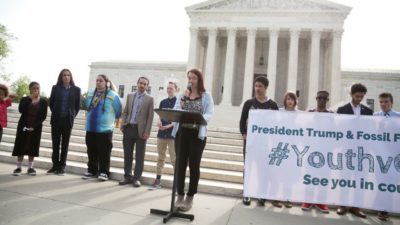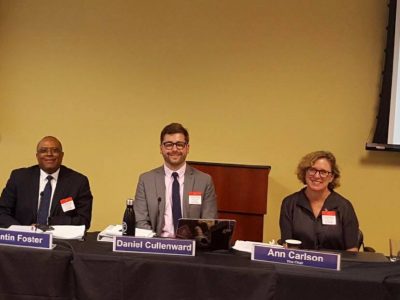Juliana and the Future of Climate Litigation
Asking judges to pass judgment on all U.S. energy policy was a bridge too far.
The Ninth Circuit threw out the Juliana litigation this morning. The two judges in the majority basically said, legalistic language, that you can't get the Green New Deal by court order. It was wrong for the Supreme Court to step in at the last minute to put the trial on hold, rather than giving the plaintiffs their day in court. But the ultimate result wasn't surprising, given the unprecedented, sweeping ruling that the plaintiffs were requesting. I don't blame t...
CONTINUE READINGNew California Report on State Climate Policies Released
Independent Emissions Market Advisory Committee Recommends Focus on Transportation, Affordability, Allowance Banking, Allowance Supply and the Effects of Overlapping Policies in the Regional Electricity Market
The California Independent Emissions Market Advisory Committee released its annual report yesterday making recommendations about California climate policy. I serve as the Vice Chair of the committee and as the Speaker of the Assembly's appointee. Our report makes five recommendations: that the state focus on the affordability of its carbon policies, with special concern about rising electricity rates and complementary policies; that the Air Resources Boa...
CONTINUE READINGThe Bleak California Housing Picture By Numbers
Key recent studies and data can inform the legislative debate
As the debate over SB 50 and other state legislative efforts to boost California's housing supply heats up, it's worth reviewing some of the data about how dire the housing situation is in the state. Here are some tidbits: High Home Prices and Rents: According to the California Legislative Analysts Office, the average California home costs about two-and-a-half times the average national home price, at $440,000 (and much higher in major metro areas). This price di...
CONTINUE READINGCongress Mandates Pentagon Climate Action
The GOP’s climate denial doesn’t extend to DOD.
Everyone says climate laws can never pass Congress. But there's a major exception. Each year since Trump took office, Congress has passed climate legislation as part of Defense Department spending. Trump has signed all of those laws. In 2017, there was a congressional finding that climate change is a threat to national security. In 2018, it was a mandate for climate and energy resilience. This year’s bill was no exception. Making military bases climate resilie...
CONTINUE READINGDark Waters in Dark Times
Citizen Petition Presses EPA To Call Chemicals in Environmental Docudrama "Hazardous Waste"
This holiday season, A-list actors drew moviegoers to a film with a distinctly un-Hollywood plot line: A company dumps thousands of pounds of toxic, long-lived chemicals (PFAS, or per-and polyfluoroalkyl substances) into unlined pits that drain into a farming community’s drinking water. Local residents fall ill, some terminally. A heroic attorney (Mark Ruffalo) represents them pro bono for years at great personal cost (neglected spouse Anne Hathaway). When ...
CONTINUE READINGThe Real Lesson From Madrid’s Failed Climate Conference? Spain’s Success On Urban Quality of Life & Carbon Emissions
Southern European nation excels at walkability, reduced emissions & resident happiness
Tea in Madrid's Plaza de San Ildefonso The UN climate conference in Madrid last month may have ended poorly, but conference attendees had a big success story right in front of them in the host country. Spain’s success achieving efficient – and enjoyable – land use and transportation outcomes is a model other countries and states should emulate to address climate change. Spanish cities and towns feature many remarkable urban spaces, not unlike those found ...
CONTINUE READINGMisunderstanding the Law of Causation
Trump's NEPA proposal flunks Torts as well as Environmental Science 101.
Last week's NEPA proposal bars agencies from considering many of the harms their actions will produce, such as climate change. These restrictions profoundly misunderstand the nature of environmental problems and are based on the flimsiest of legal foundations. Specifically, the proposal tells agencies they do not need to consider environmental “effects if they are remote in time, geographically remote, or the product of a lengthy causal chain.” The proposal also...
CONTINUE READINGPride Goeth Before a Fall
Trump thinks he can tell courts how to interpret NEPA. He's wrong.
White House has just released its proposed revisions to the rules about environmental impact statements. The White House Council on Environmental Quality (CEQ) simply does not have the kind of power that it is trying to arrogate to itself. The proposal is marked by hubris about the government's ability to control how the courts apply the law. That hubris is evident in the proposal's effort to tell courts when lawsuits can be brought and what kind of remedies th...
CONTINUE READINGAndy and Dave Shoot the Breeze
An inside look at the Trump Administration.
[Open with a shot of Interior Secretary David Bernhardt at his desk with his phone to his ear. Ring tone in the background. Split screen after EPA Administrator Andrew Wheeler picks up.] Bernhardt: Hey Andy, how ya doin’? How’s life in the Inferior Department? Wheeler: Not so bad, Davey boy, not so bad. B: You in the clear on the Ukraine stuff? [Camera switches to Wheeler] W: Never even heard of the country until a couple of months ago. [chuc...
CONTINUE READINGCalifornia’s Major Housing Bill, Take 3: New Amendments Announced For Local Flexibility
Will Governor Newsom now put his weight behind Sen. Wiener's SB 50?
California State Senator Scott Wiener launched his third legislative attempt today at boosting California's housing supply. SB 50 aims to address the state's massive housing shortage, which has resulted in high home prices and rents, gentrification, displacement, inequality, homelessness, and a mass middle-class exodus to high-emission states like Texas and Arizona. Because this housing undersupply is caused primarily by restrictive local land use polici...
CONTINUE READING












